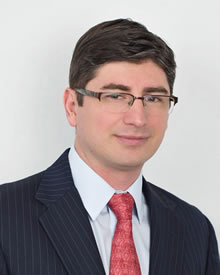Dr. Dmitriy Nikolavsky
Skilled Reconstructive Urologist Specializing in Transgender Urology
Dr. Dmitriy Nikolavsky is a Reconstructive Urologist who treats post-operative urinary complications for patients who have undergone FTM Phalloplasty with urethral construction. Dr. Nikolavsky also provides long term follow-up care for these patients.
Dr. Nikolavsky is an Assistant Professor of Urology and the Director of the Reconstructive Urology department at SUNY Upstate Medical University, in Syracuse NY. He is a Diplomat of the American Board of Urology (2014), and has authored and co-authored numerous academic articles on Reconstructive Urology. In 2015, Dr. Nikolavsky visited countries around the world as an invited conference speaker, including Peru, Portugal and Russia where he spoke about urethral reconstruction for strictures in FTM phalloplasty and the urological considerations of radial forearm phalloplasty.
Dr. Nikolavsky maintain memberships with several professional organizations including:
- American Urological Association (AUA)
- Society of Genitourinary Reconstructive Surgeons (GURS)
- World Professional Association for Transgender Health (WPATH)
Common urinary complications after FTM Phalloplasty include strictures, fistulas and abscesses. These complications can significantly affect quality of life, and repair surgeries are complex, especially if the patient is experiencing multiple concurrent complications.
The role of the Reconstructive Urologist in this context is to diagnose patients presenting with post-operative urinary conditions, and provide a solution to correct the condition and restore normal urinary function.
Dr. Nikolavsky regularly connects with Phalloplasty surgeons as well as other Reconstructive Urologists to stay current on the best practices in transgender urology. Plus, the nurses and office staff at the Reconstructive Urology department at SUNY are experienced in working with transgender men.
Do You Need a Reconstructive Urologist?
Dr. Nikolavsky does a free initial consultation by phone. Surgery dates can be secured with very short notice.
Recent publications:
Staged Urethroplasty for Repairs of Long Complex Pendulous Strictures of a Neophallic Urethra
Jessica Schardein, Matthew Beamer, Michelle A Kittleman, Dmitriy Nikolavsky. Urology, Jan 28 2022.
A staged urethroplasty is a feasible option for transgender men with long complex penile strictures of the neophallus. This technique demonstrates promising early functional outcomes and high patient satisfaction.
One or Two Stage Buccal Augmented Urethroplasty has a High Success Rate in Treating Post Phalloplasty Anastomotic Urethral Stricture
Matthew R Beamer, Jessica Schardein, Nabeel Shakir, Min Suk Jun, Rachel Bluebond-Langner, Lee C Zhao, Dmitriy Nikolavsky. Urology. 2021 Jun 10;S0090-4295(21)00471-4.
Single-stage repairs are feasible for patients with anastomotic strictures who have well vascularized tissue and no prior single-stage buccal mucosa augmented urethroplasty failures. Staged repairs are feasible for patients with poor tissue quality. Proper patient selection is important for successful reconstruction.
Single-stage Double-face Buccal Mucosal Graft Urethroplasty for Neophallus Anastomotic Strictures.
Schardein J, Beamer M, Hughes M, Nikolavsky D. Urology. 2020 Sep;143:257.
After gender-affirming phalloplasty the anastomosis between the perineal urethra (pars fixa) and the penile urethra is the most common site of stricture. Excisional urethroplasty after phalloplasty is known to have high failure rates due to poor vascularization of neourethra. Our objective is to demonstrate the feasibility of a single-stage repair of neophallus anastomotic strictures using a "double-face" urethroplasty technique.
Management of Vaginoplasty and Phalloplasty Complications.
Schardein JN, Zhao LC, Nikolavsky D. Urol Clin North Am. 2019 Nov;46(4):605-618.
Although there have been several modifications to prior techniques as well as development of new techniques over the years, complications are still common after vaginoplasty and phalloplasty. This article focuses on the most common complications as well as the evaluation and management of those complications.
Presenting Complications to a Reconstructive Urologist After Masculinizing Genital Reconstructive Surgery.
Dy GW, Granieri MA, Fu BC, Vanni AJ, Voelzke B, Rourke KF, Elliott SP, Nikolavsky D, Zhao LC. Urology. 2019 Oct;132:202-206.
To evaluate the presenting complications of patients to reconstructive urologists after masculinizing gender affirming genital reconstructive surgery (GRS) performed elsewhere. There are several common presenting urologic complications after masculinizing GRS. Patients may present to reconstructive urologists early after GRS performed elsewhere. The long-term outcomes of GRS deserve further study.
Urologic Complications After Phalloplasty or Metoidioplasty.
Nikolavsky D, Hughes M, Zhao LC. Clin Plast Surg. 2018 Jul;45(3):425-435.
In the past decade, issues facing transgender individuals have come to the forefront of popular culture, political discourse, and medical study. The evaluating physician should have knowledge of the reconstructed anatomy, as well as potential postoperative complications. This knowledge will aid in providing appropriate care and recognizing issues that may require specialized urologic care. Transgender anatomic definitions and a synopsis of common urologic complications specific to transmen, including urethrocutaneous fistulae, neourethral strictures, and persistent vaginal cavities are discussed.
Urologic Sequelae Following Phalloplasty in Transgendered Patients.
Nikolavsky D, Yamaguchi Y, Levine JP, Zhao LC. Urol Clin North Am. 2017 Feb;44(1):113-125.
Transgender patients at various stages of their transformation will present to urologic clinics requiring general or specialized urologic care. Knowledge of specifics of reconstructed anatomy and potential unique complications of the reconstruction will become important in providing urologic care to these patients. In this article, we have concentrated on describing diagnosis and treatment of the more common urologic complications after female-to-male reconstructions: urethrocutaneous fistulae, neourethral strictures, and symptomatic persistent vaginal cavities.
More about Dr. Dmitriy Nikolavsky »
